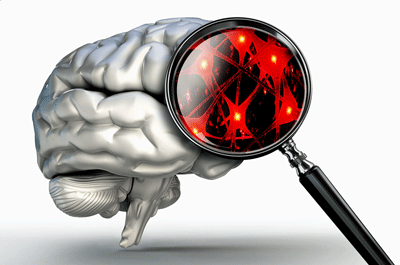Can exercise protect against “inflammaging”?

The post I wrote last week talked about the exciting connection between exercise and the immune system (http://fasttwitchgrandma.com/increase-your-immune-system-through-exercise/). I specifically focused on one immune factor, known as interleukin-6 (IL-6), that not only serves immune functions but also acts to enhance metabolic processes, like burning fats and sugars. Considering that immune factors are affected by exercise, I wanted to dig a bit deeper into understanding how they affect our immune system and specifically, the immune system as it relates to the brain.
The brain has innate immune cells, known as microglia. They constitute approximately 15% of all the brain’s cells. These cells serve as the first line of defense against any pathogenic substances or cellular damage that occurs within the central nervous system (i.e., the brain and spinal cord). Microglia both consume foreign material as well as release inflammatory immune cells, such as IL-1β, IL-6, and IL-10. As we age, the brain’s immune system is activated by debris that builds up between and around neurons (brain cells). This immune system response leads to increased brain inflammation, which may lead to problems in cognitive functioning and diseases such as mild cognitive impairment and Alzheimer’s disease. For example, a hallmark of Alzheimer’s disease is the so called plaques and tangles, which are in essence abnormal protein formations. These plaques and tangles are recognized by the body as “foreign”, and so an immune response is mounted that leads to increased inflammation.
Is there anything we can do to help decrease the inflammatory brain processes that occur with aging? A new, exciting study that was published this July in Brain, Behavior and Immunity suggests that all we need to do is exercise.
Aging is often accompanied by increases in depression and anxiety, and neuroinflammation (i.e., inflammation that occurs in the brain) has been linked to these dysregulated mood states. Dallagnol and colleagues (2016) used exercising rodents to ask whether physical activity could help to decrease depression and anxiety as well as brain inflammation. Old mice were exposed to either a sedentary or voluntary running wheel experience for eight weeks. After this experience, depression and anxiety levels were measured using behavioral tasks known as the tail suspension task and the open field test, and inflammatory markers were measured in the hippocampus, a brain region involved in learning and memory. Compared to their sedentary counterparts, rodents that spent two months running showed an increased propensity to locomote to the center of an open space (a test of anxiety) as well as move more while being suspended by their tails (a test of depression – sad I know!). These results indicate that physical activity decreased both anxiety and depression levels in aged mice. The behavioral improvements were accompanied by decreased expression of the inflammatory markers IL-1β and IL-10 in the hippocampus. Unfortunately, no correlations were conducted to determine whether these two findings were connected. Future research will be needed to examine whether the exercise-induced improvements in mood are related to the decreases in inflammatory markers. Additionally, considering the findings in the hippocampus, future research should examine whether the exercise-induced improvements in the brain’s immune system are related to enhancements in long-term memory, a process dependent on the hippocampus.
A recent human study helps to put this information into a more clinical and human-relevant perspective. A group of scientists in Brazil wanted to determine whether a 16-week multimodal exercise program (three one-hour sessions per week) could simultaneously enhance cognitive functioning and decrease blood inflammatory markers in a group of healthy individuals as well as patients with mild cognitive impairment (Nascimento et al., 2014). At the onset of the study, compared to healthy participants, patients with MCI performed worse on tests of cognitive ability and had higher levels of the inflammatory markers TNF-α (tumor necrosis factor alpha) and IL-6. After 4 months of exercise, levels of TNF-α and IL-6 were decreased in both groups, and patients with MCI scored better in tests of executive functioning and attention/concentration – findings that reflect the animal literature!
This work reveals that exercise helps to protect the brain against “inflammaging” – or the phenomenon of increased brain inflammation as we age. Dallagnol et al. (2016) note that, “neuroinflammation is a mechanism of brain aging, which increases sensitivity to cumulative life stresses and other insults.” Chronic exposure to molecules that cause brain inflammation may have degenerative effects on the brain that lead to a variety of chronic illnesses such as mild cognitive impairment and Alzheimer’s disease. Excitingly, both rodent and human research are revealing that a regular exercise program may help to decrease normal, inflammatory processes that occur in the brain, thus helping to prevent, or at least delay the onset of, cognitive decline.
References:
Dallagnol, K. M. C., Remor, A. P., da Silva, R. A., Prediger, R. D., Latini, A., & Aguiar, A. S. (2016). Running for REST: physical activity attenuates neuroinflammation in the hippocampus of aged mice. Brain, Behavior, and Immunity.
Manuela Crispim Nascimento, C., Rodrigues Pereira, J., Pires de Andrade, L., Garuffi, M., Leme Talib, L., Vicente Forlenza, O., ... & Stella, F. (2014). Physical exercise in MCI elderly promotes reduction of pro-inflammatory cytokines and improvements on cognition and BDNF peripheral levels.Current Alzheimer Research, 11(8), 799-805.
























